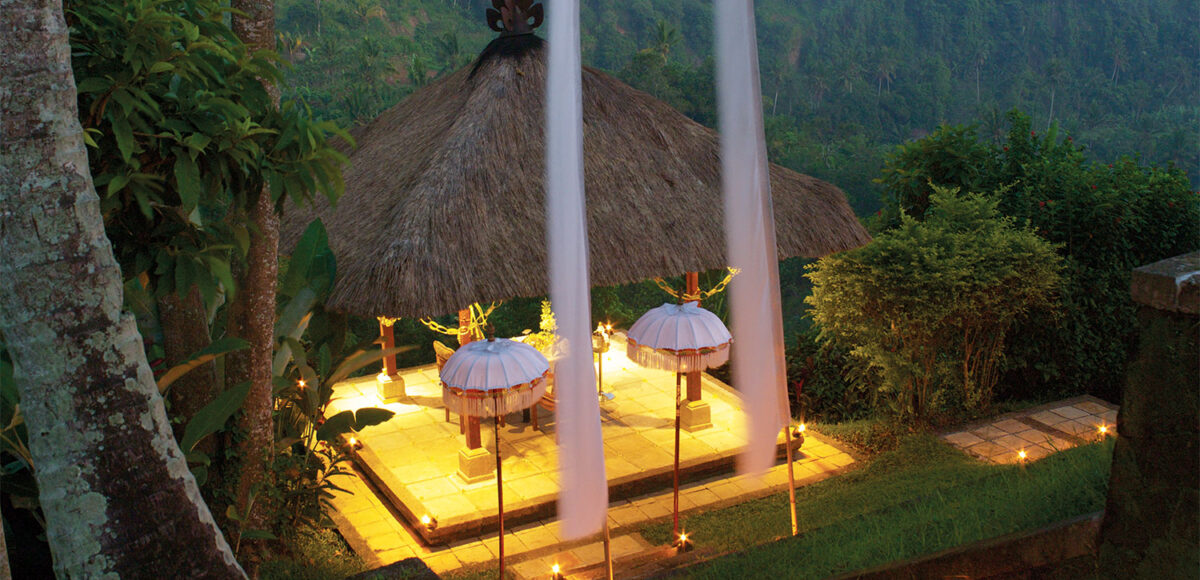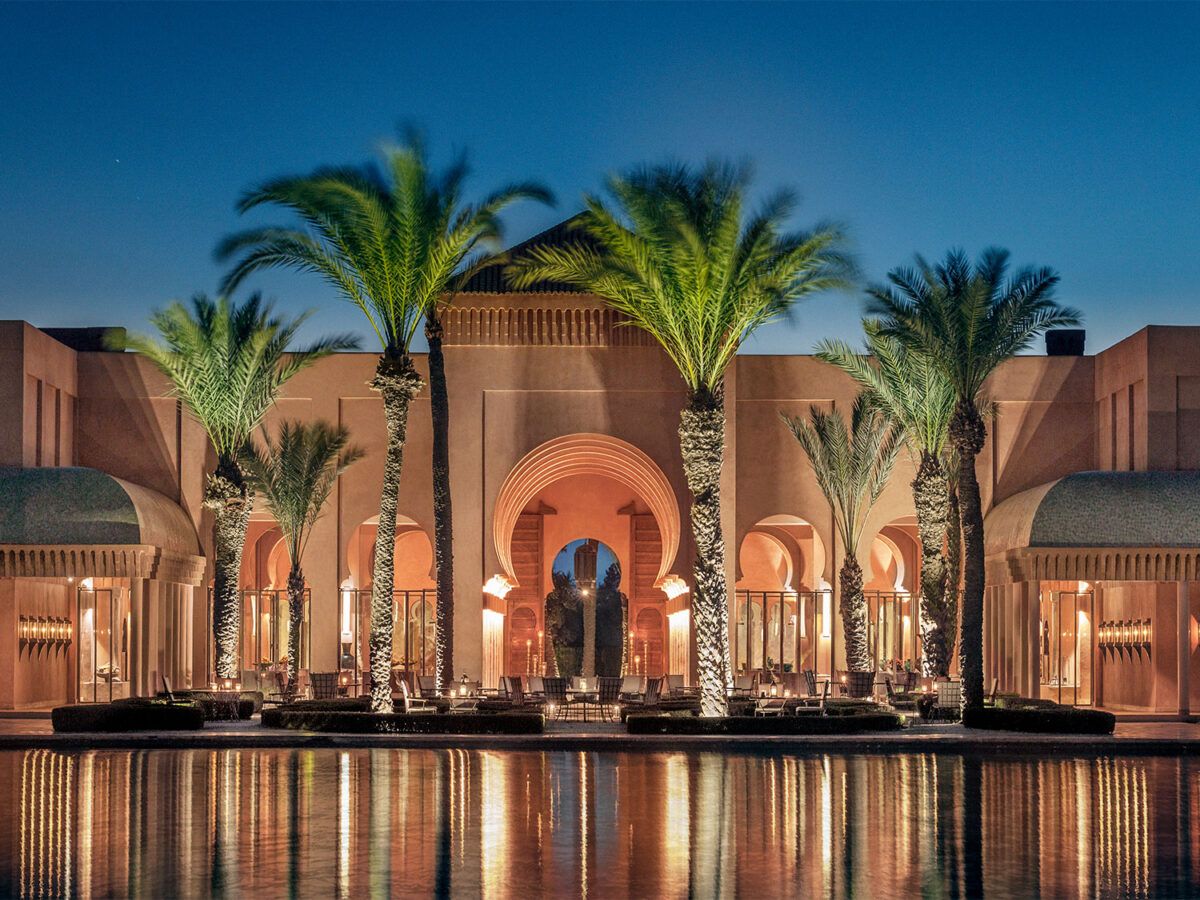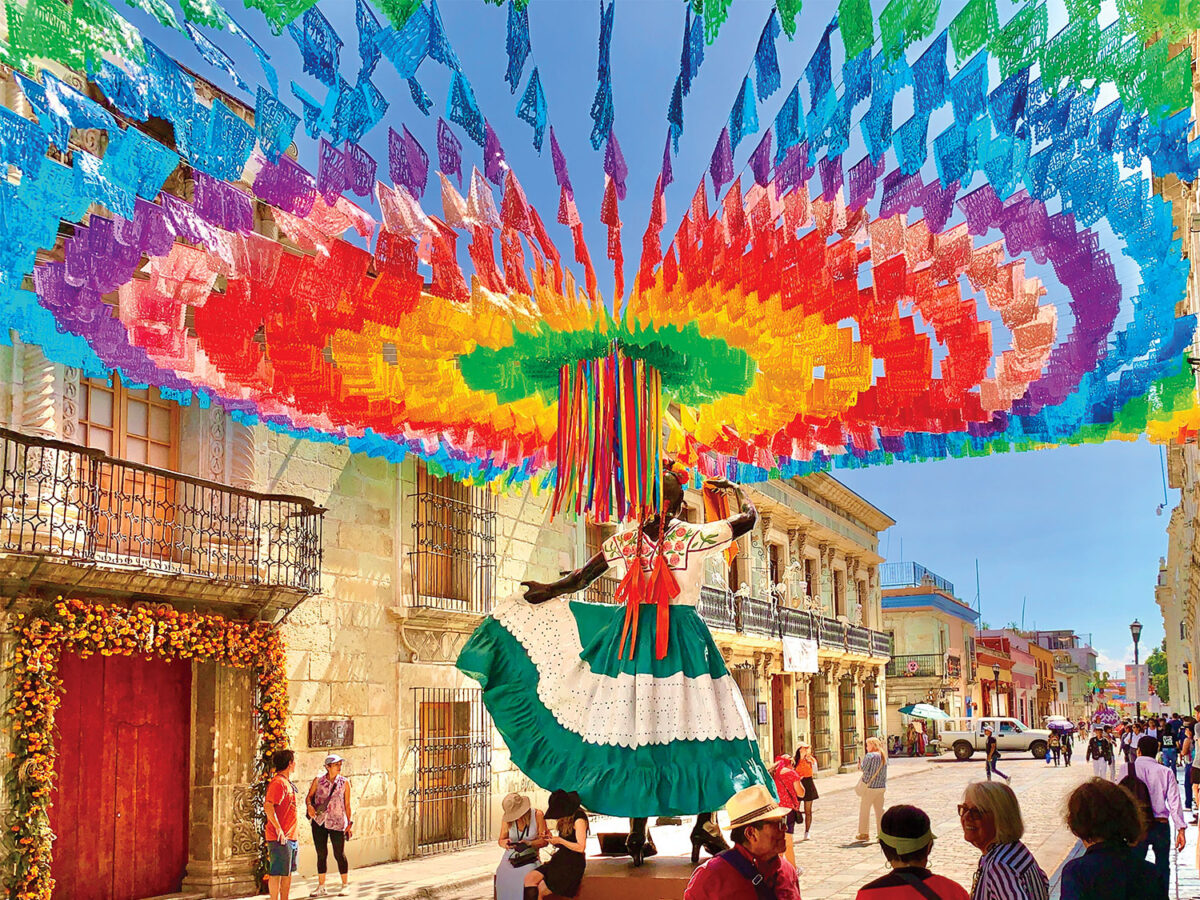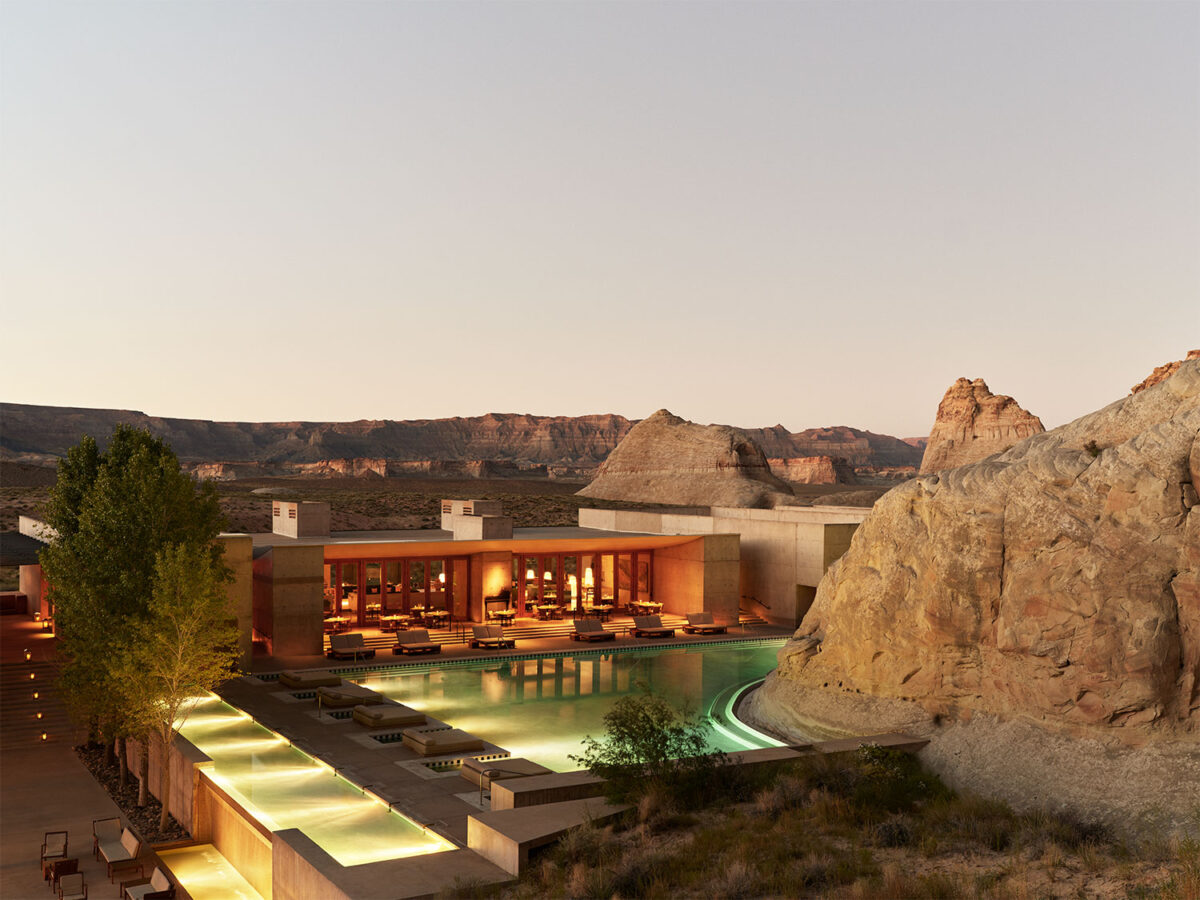A guided look at Aman’s five stunning resorts and duo of exclusive experiences in Indonesia
While the Aman brand didn’t originate in Indonesia, it certainly established its foundation there, with much of its hospitality heritage stemming from the Southeast Asian country’s architectural vernacular, as well as the rich Eastern philosophies of wellness. The Aman brand debuted with the opening of Amanpuri in Phuket, Thailand, in 1988, followed by the opening of Amandari in Indonesia’s Balinese cultural capital of Ubud in 1989. In the years since, Aman opened Amankila and Amanusa in 1992, Amanwana in 1993, Amanjiwo in 1997, and launched a sailing yacht, Amandira, through the area in 2015.
“Indonesia is the heritage and background of the Aman brand,” says Jann Hess, the General Manager of Amankila and Regional Director of Aman Indonesia. “The strongest DNA of the brand comes from the people here, and the ethos of how the brand always aims to blend in with local culture stems from here too.”
While these Aman properties are all well-established, the region’s increasing popularity over the years has made it prime for new development, as well as for people to rediscover the foundation and heart of the Aman brand, with the U.S. bringing more visitors to Aman’s properties than any other region. “Indonesia has more than 17,000 islands and more than 700 spoken languages, as well as breathtaking landscapes and culture,” says Hess. “It’s also 3,600 miles wide from east to west, so it takes some time to fully explore.” Here, the experienced hotelier, who has spent the last decade with Aman Resorts, guides us through what makes each property particularly unique—as well as what’s ahead for these legacy properties.
Amandari— An Enchanted Forest Haven
“In the beginning days of the Aman brand, the idea was that the resorts would feel like homes where you are welcoming friends,” says Hess. Nestled in Bali’s uplands, about 15 miles from the sea, Amandari is surrounded by Bali’s most verdant landscapes, filled with Hindu temples and shrines, rainforests, and numerous craftspeople and artisans. Here, spacious suites offer a variety of residential-inspired configurations, complete with private pools that reflect the tonal greens of their surroundings, as well as open-air rooms for seamless integration with the outdoors to let in views of the Ayung River Gorge and River Valley, rice paddies or landscaped gardens. Materials like teak, marble, as well as thatched roofs and coconut define the building palette.
“At Amandari, you can see how from the beginning, the Aman brand always developed in a way that blended in with what was already around it. It sets the standard for all the resorts to follow,” says Hess. Today, guests at the property can visit the neighboring village filled with galleries and artists; be led by an Aman guide through local markets; explore the nearby iconic temples; go on a cycle journey through rice fields; trek alongside a picturesque lake; experience Balinese spiritual counseling; or simply bask in the environment and absorb the stunning nature.
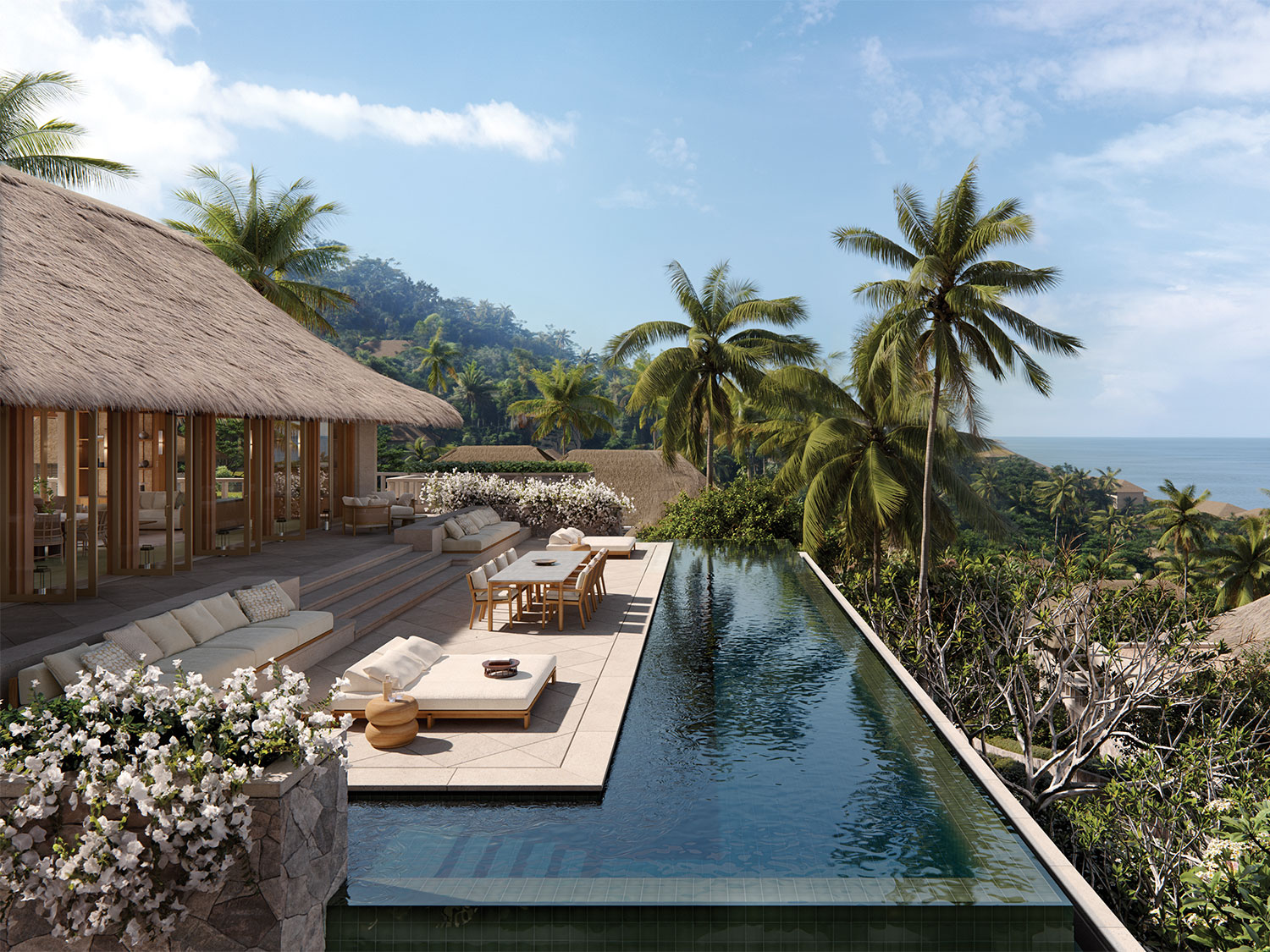
AMAN RESIDENCES, AMANKILA
Amankila—A New Home for Aman Lovers
Historically, Bali was divided into nine kingdoms, each ruled by a different royal family. Set in the ancient kingdom of Karangasem, on the eastern side of Bali, Amankila is set among some of the island’s most culturally significant sites and compelling landscapes. “It’s hard to find a place more unique than this,” says Hess. “Bali is quite large [about 2,230 square miles], but there’s so much you can do here without going too far.” Hess points to Balinese cultural experiences like visiting one of the water palaces, Tirta Gangga, hiking along the stunning gray-sand coastline, as well as snorkeling and diving.
First built in 1992 by architect Ed Tuttle, who is responsible for other Aman resorts like Amangani and Amanzoe, the property has long inspired guests with its cliffside home featuring sweeping views of the Lombok Strait, as well as its intimate accommodations with canopied beds, soaking tubs and private terraces. Now, Amankila is creating just nine exclusive residences, designed by Singapore-based Studio NvS. The expansive properties range from 29,000 to 61,000 square feet, boasting outdoor terraces, private pools and an elevated hillside position to take in sweeping ocean views.
“Each villa is being designed to host multigenerational families and/or groups of friends,” describes Hess. “They’re created on a large scale, each comprised of elegant pavilions and seamlessly blending with the rest of the resort.”
Residences will range from three to five bedrooms, with homeowners having the option to add additional pavilions for spaces like an office, media room or meditation lounge. Owners will have full and preferred access to all hotel amenities and services, in addition to the Aman Private Office, which provides global services across the entire Aman portfolio.
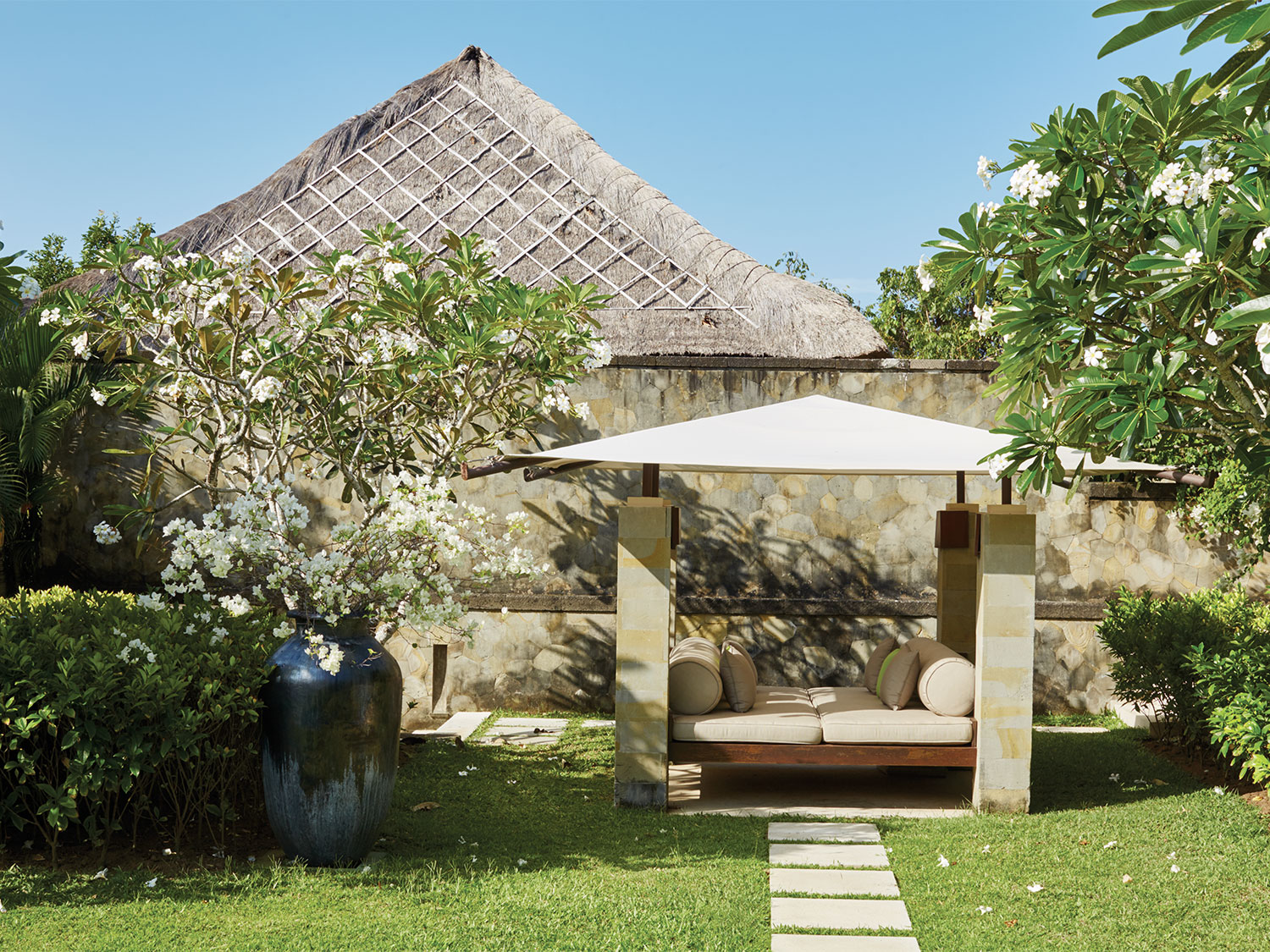
Aman Villas at Nusa Dua—An All—Villa Resort for a Truly Exclusive Stay
Golden beaches, oceanside temples and frangipani-scented hillsides set the background at Aman Villas Nusa Dua, where each private, two-story villa comes with a team of two butlers and a private chef. The all-villa resort feels more like its own private residential enclave, where its seven homes, ranging from 45,552 square feet to 58,727 square feet, occupy a total of 153 private acres. Since opening in 1992, the property has been catering to guests seeking customized experiences in a unique setting. Its position on Bali’s southernmost peninsula provides proximity to the Bali National Golf Club as well as some of the island nation’s most stunning white-sand beaches. Complementing the stunning setting, the architecture of the villas comes from Kerry Hill Architects, who have designed Aman resorts across the world, including the forthcoming property in Beverly Hills. “Kerry Hill’s work, especially in these early Aman properties, really set the tone for the brand, and you can see how decades later, not only is it still relevant, but it’s also still inspiring,” says Hess.
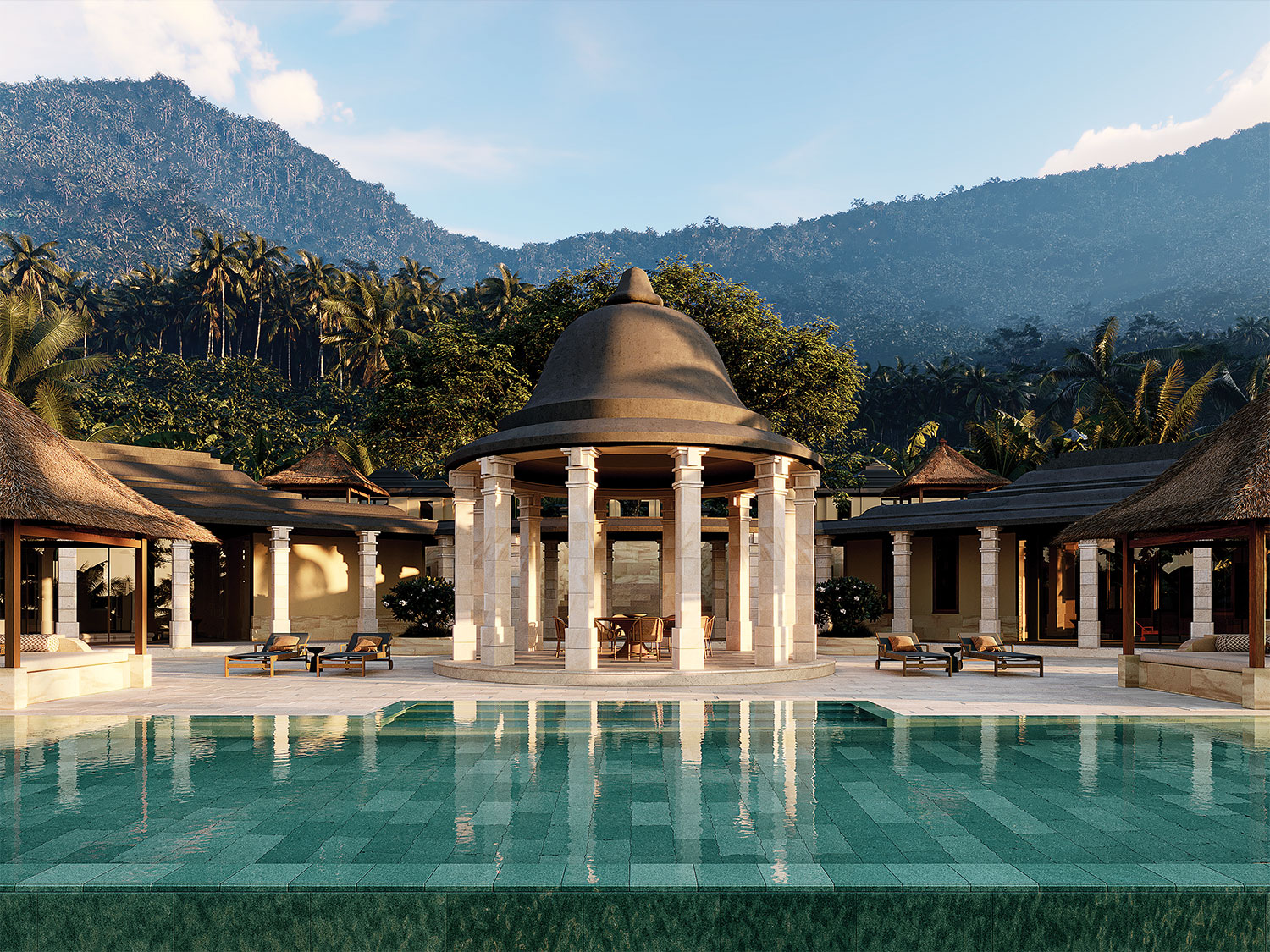
RENDERING COURTESY OF AMAN,
Amanjiwo—Where History Meets a Contemporary Sense of Serenity
Overlooking the world’s largest Buddhist sanctuary, in the bucolic bliss of central Java, Amanjiwo draws guests with its tranquil setting and natural attractions. “The resort overlooks the UNESCO World Heritage Site of Borobudur, which is a 9th-century Mahayana Buddhist temple,” says Hess. “There’s a feeling of serenity when you’re here, so much so that ‘Amanjiwo’ actually translates to ‘Peaceful Soul.’” Here, the resort’s 33 rooms form a semi-circle around the central spaces, with views looking out to the cascading rice paddies, Kedu Plain, and four volcanoes. The inland setting, just 35 miles from the coast, is deeply immersed in the island’s rich culture, with guests frequently coming to experience Aman-led private visits to Borobudur, trekking into the nearby mountains, or simply resting in the tranquil landscape and lounging by the pool.
The architecture of the property deeply reflects its storied surroundings, with legendary architect Ed Tuttle designing accommodations with local stone, gracious pavilions and walled gardens. “Ed Tuttle was also the architect of the first Aman, Amanpuri in Phuket, and helped establish the brand’s design vocabulary, looking to merge modern comforts with historic and Indigenous attributes,” says Hess.
Although the options for accommodations range as large as the Dalem Jiwo Suite with two bedrooms, each in their own pavilion, a Javanese-stone swimming pool, two outdoor lounging bales and nearly 13,000 square feet of private space, those seeking to make their refuge even more personal have the option of purchasing one of the forthcoming private residences at Amanjiwo. “We’re currently in the process of creating four villas, each in the language of the current property and Ed Tuttle’s direction,” says Hess. “We’ll never create more than four, though, because it’s important that the property stays small and doesn’t impose on the protected UNESCO site.”
Construction of the villas is already underway, with options for three or four bedrooms, and designs by Sydney-based Manasara architects, who have created various residences and projects throughout Indonesia. The residences will be placed above the hotel for elevated views, and each will feature pavilions for bedrooms, living and dining, as well as expansive terraces and gardens, complete with an 18-meter private pool. Lots range from approximately 30,200 square feet to 37,700 square feet, but should owners ever feel the need to leave their environs, they have full access to all of the amenities at the Aman resort.
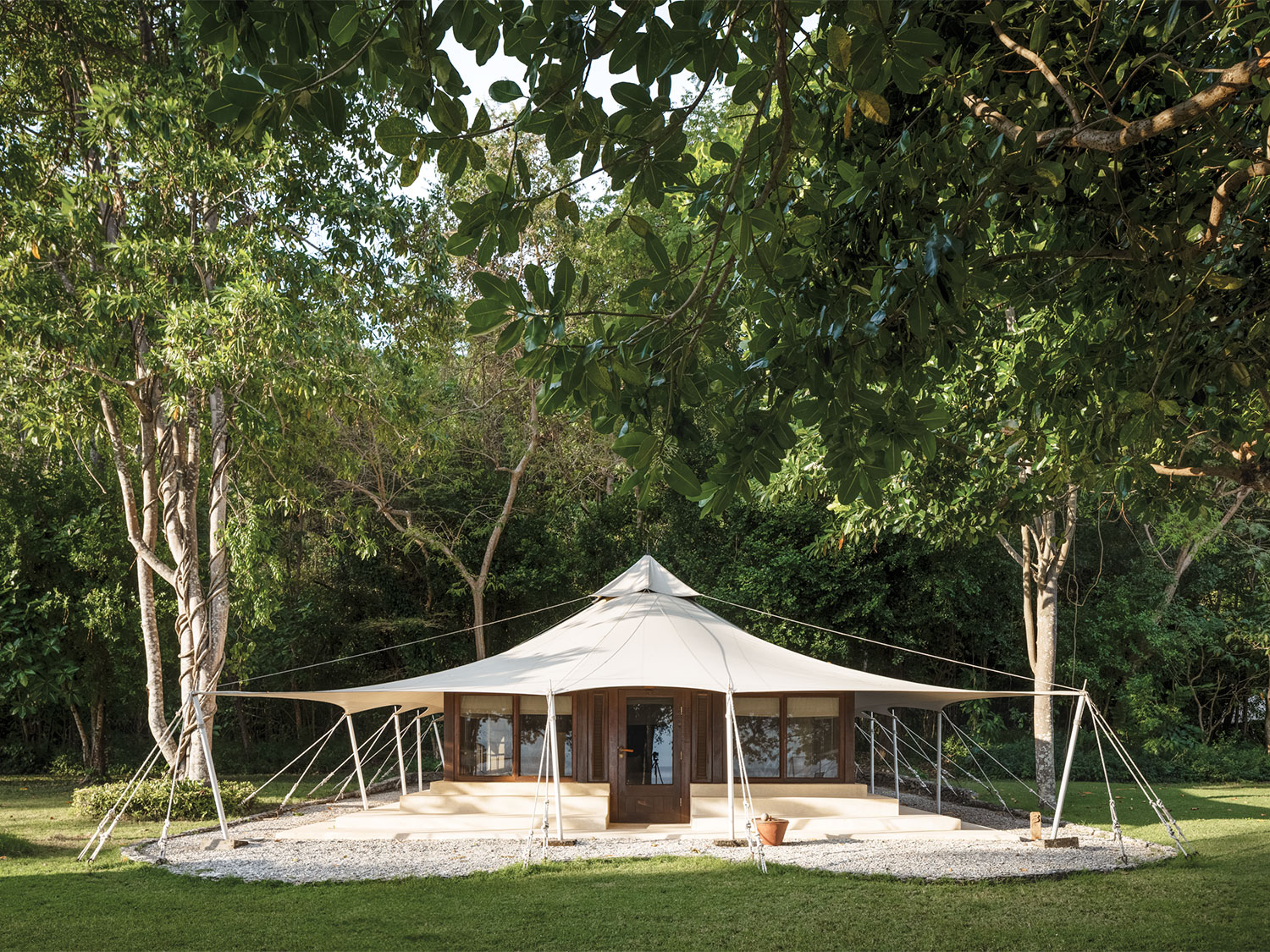
PHotos courtesy of Aman
Amanwana—Tented Luxury on the Remote Moyo Island
There are tented camps, and then there are the tented camps that Aman creates. Those familiar with Amangiri’s Camp Sarika experience will recognize the full-nature immersion that Aman creates with its camp-style retreats. At Amanwana, instead of being surrounded by a boundless desert oasis, guests have the unique experience of waking up on Moyo Island. Measuring 135 square miles and accessible only by boat or helicopter, the island is part of the Moyo-Satonda National Park and offers calm turquoise waters, lush savannahs and rich forests. Here, just 17 tents rest in a tranquil bay on the western coast of the island. Each of the permanent tents measures 625 square feet and features plush beds, picture windows, wooden decks, full bathrooms with showers, and views of either the ocean or the jungle. “It’s unique that Aman can offer these five resorts in one country for guests to experience,” says Hess. “Each one is designed in complete harmony with its setting to offer something different to each guest. Of course, they can be experienced individually, but when a guest books stays across multiple properties, we can really create a personalized itinerary so that each retreat offers meaningful culture, memorable experiences, and the Aman-level of luxury.”
While the untouched setting of Amanwana is perfect for swimming with whale sharks in the Saleh Bay, scuba diving and snorkeling in the nearby untouched reefs, trekking through the jungle to explore hidden waterfalls, or experiencing a massage at the open-air spa set among tamarind trees, the emphasis here is always on the feeling of being a million miles away in a place still almost completely undiscovered by mainstream travelers.
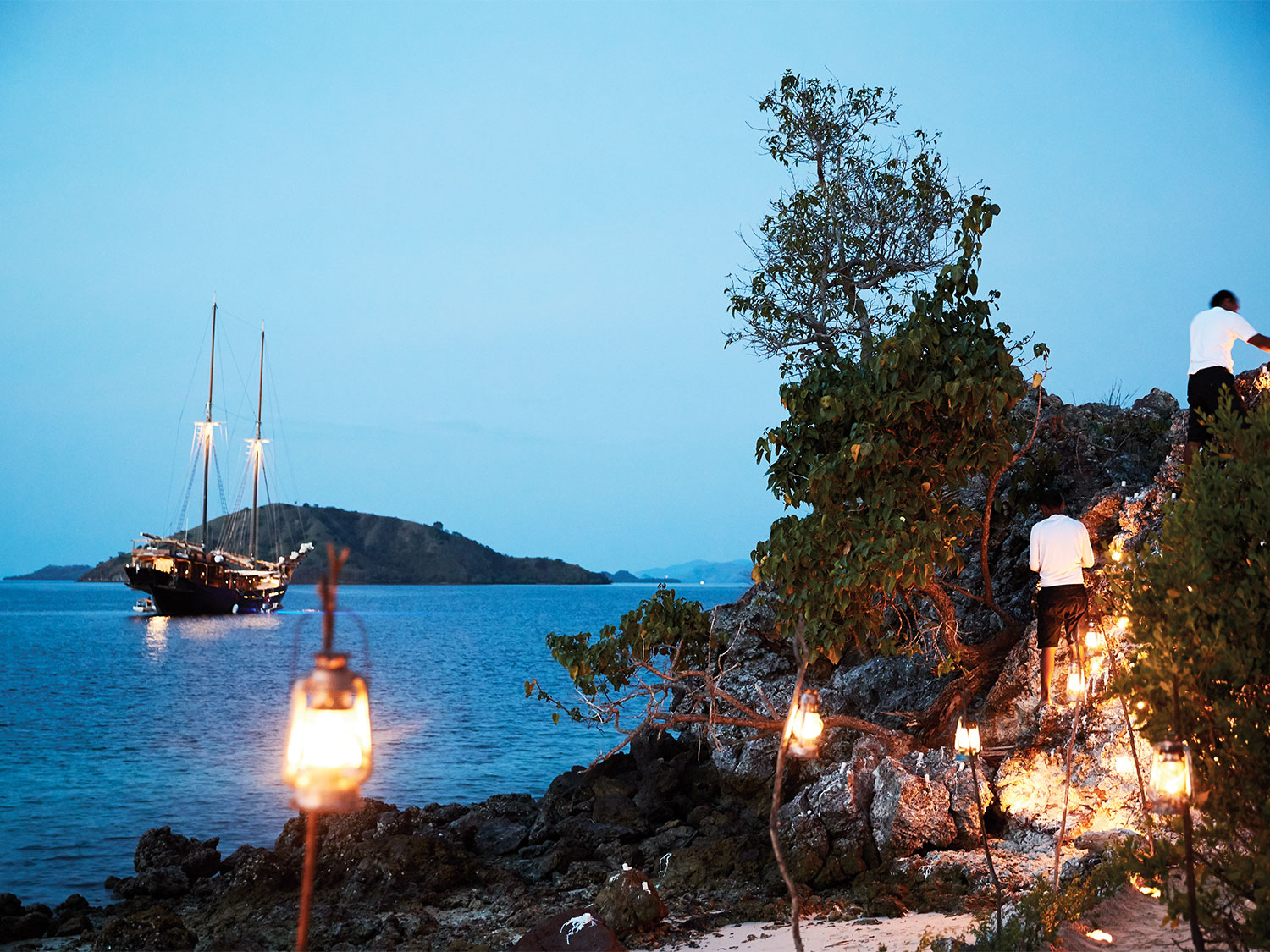
Amandira and Aman By Train— Journeys Off the Beaten Path
Launched in 2015, the luxury sailing yacht Amandira is the most recent addition to the Aman Resorts portfolio in Indonesia. “This custom-built, two-masted sailing yacht is modeled after a traditional Indonesian Phinisi sailing and diving vessel,” says Hess. “It’s a fantastic complement to our properties on land because it gives our guests such a unique way to see Indonesia and its many islands from a different standpoint.”
Itineraries for Amandira include journeys to the Spice Islands, where powder-white-sand beaches merge with volcanic mountains and uninhabited shorelines, as well as the Komodo Cruise Expedition, where guests track and photograph the elusive Komodo dragon in its UNESCO-protected home of the Komodo National Park. Both journeys are offered only a few times a year due to weather, but each includes an incomparable stay aboard the 52-meter Amandira, where just five cabins ensure an intimate experience, and a crew of 14 ensures top-tier service.
“For another unique Aman experience, we have the Aman train journey,” says Hess. “It’s something we came up with during the pandemic that’s become a really special and popular experience.” Just twice a month, Aman guests arriving to Amanjiwo via Jakarta can board the luxury carriage, which seats 10 guests, for a 6.5-hour scenic ride. “We have a resident anthropologist on board who talks about Indonesian culture and sites you see along the way, which is a wonderful way to ease into and learn about the country,” says Hess. “It’s also a great reminder that some of the best ways to explore and absorb Indonesia are by sitting back and slowing down.”



